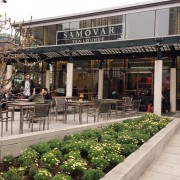 Chinese New Year is a time when the most enticing foods are served in plenty. If you are looking for a well-rounded cup of Chinese tea to go along with those bites and meals, then there’s no need to look any further. Red Blossom Tea Company’s Heritage Beido, also known as Grand Scarlet Robe, is a rich Wuyi Oolong, grown from cultivars thought to be direct descendents of very rare Da Hong Pao mother trees.
Chinese New Year is a time when the most enticing foods are served in plenty. If you are looking for a well-rounded cup of Chinese tea to go along with those bites and meals, then there’s no need to look any further. Red Blossom Tea Company’s Heritage Beido, also known as Grand Scarlet Robe, is a rich Wuyi Oolong, grown from cultivars thought to be direct descendents of very rare Da Hong Pao mother trees.
 Grand Scarlet Robe…now doesn’t that sound luxurious? Well, in taste and price, it is. Da Hong Pao (the Chinese translation of Grand Scarlet Robe) is the name of the mother trees that this Heritage Beido is thought to have derived from. Often called the world’s most expensive tea or the king of oolongs, Da Hong Pao is usually reserved for wealthy connoisseurs and dignitaries in China. It’s rumored that even President Nixon received some as a gift from Chairman Mao during his visit to China in 1972.
Grand Scarlet Robe…now doesn’t that sound luxurious? Well, in taste and price, it is. Da Hong Pao (the Chinese translation of Grand Scarlet Robe) is the name of the mother trees that this Heritage Beido is thought to have derived from. Often called the world’s most expensive tea or the king of oolongs, Da Hong Pao is usually reserved for wealthy connoisseurs and dignitaries in China. It’s rumored that even President Nixon received some as a gift from Chairman Mao during his visit to China in 1972.
 Although some may compare this tea to a smokey Lapsang Souchong, I completely disagree. Whereas I find Lapsang to be over-the-top assertive, where you can literally taste the pine wood fire it’s burned over, this Wuyi Oolong is well-balanced and smooth. When brewed with care, you can taste all of its sweet, savory, fruity, and roasty notes equally. This is one beautifully harmonious sip, one that came highly recommended by the Red Blossom Tea Company staff.
Although some may compare this tea to a smokey Lapsang Souchong, I completely disagree. Whereas I find Lapsang to be over-the-top assertive, where you can literally taste the pine wood fire it’s burned over, this Wuyi Oolong is well-balanced and smooth. When brewed with care, you can taste all of its sweet, savory, fruity, and roasty notes equally. This is one beautifully harmonious sip, one that came highly recommended by the Red Blossom Tea Company staff.
Tasting Notes for Red Blossom Tea Company’s Heritage Beido (Grand Scarlet Robe):
BREWING TIPS: Rinse the leaves in a small amount of 200 degree F water for 1 second, then drain and discard the liquid. This will help to soften the leaves in preparation for steeping. Steep the leaves at 200 degrees F for 1 minute, 20 seconds for the first infusion. For each subsequent infusion, steep for an additional 30 seconds more than the last infusion. You should be able to get 3-4 flavorful infusions out of these leaves. I like to brew this tea in very small batches, in a small teapot or gaiwan for maximum control during brewing.
THE TEA: Blackish-brown, wiry, twisted leaves. Some of the leaves are up to 2 1/2 inches in length.
THE SCENT: Strongly woody, like a whiff of smoldery leaves after a light charring. There’s something tobacco-like about the scent, in the best way possible.
THE STEEP: A rich, golden amber. Toasty, warm, and reminiscent of peach pit. The tea has a honey-like, floral sweetness with caramel and toffee notes–a result of its traditional “heritage” charcoal roasting.
GET IT: In San Francisco’s Chinatown at the Red Blossom Tea Company, or online at the Red Blossom Tea Company site.
FOOD PAIRING: This tea is going to be delicious with Chinese New Year Favorites like Siu Mai Dumplings, BBQ Pork Buns (steamed or baked), or Egg Custard Tarts. For an Asian American twist, serve them with Waffle Cone Fortune Cookies with some auspicious messages tucked inside!







